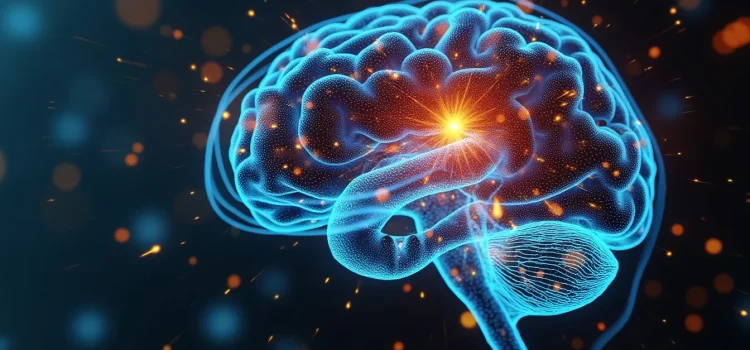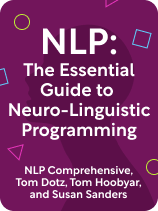

This article is an excerpt from the Shortform book guide to "NLP: The Essential Guide to Neuro-Linguistic Programming" by Tom Hoobyar, Tom Dotz, and Susan Sanders. Shortform has the world's best summaries and analyses of books you should be reading.
Like this article? Sign up for a free trial here.
What happens in your mind when you think about past experiences or future events? How do your senses shape the way you interpret and respond to different situations?
Understanding sensory information processing reveals the hidden mechanisms behind your thoughts, feelings, and behaviors. Your brain constantly collects and organizes data from your environment, creating a complex web of sensory impressions and memory associations that guide your responses to every experience.
Read on to explore how your brain transforms raw sensory data into meaningful thoughts and emotions, and discover ways to take control of this process.
Sensory Information Processing
Hoobyar, Dotz, and Sanders argue that the only way to change something in your life is to change the way you interpret, feel about, and respond to it. And, to change the way you feel about and respond to it, you need to change the way you think about it.
Though changing thoughts sounds simple, it’s often difficult because thoughts are somewhat intangible and difficult to control. However, the authors explain that this difficulty arises only when you’re not conscious of the processes that underlie your thoughts—that is, where your thoughts come from and why they manifest in the way that they do.
They suggest that understanding these underlying processes is key to making thoughts feel more tangible, and, as a result, easier to change. At its core, this involves understanding how sensory information processing shapes our perceptions and subsequent thoughts. Therefore, we’ll explore the processes underlying thought formation, covering how:
- Your brain processes data from your environment.
- Your thoughts manifest as sensory impressions.
- Memory associations trigger related sensations.
- Sensory nuances influence all your experiences.
(Shortform note: Similarly, James Allen (As A Man Thinketh) argues that you must understand why you think the way you do before you can change anything in your life. Without this understanding, you’re more likely to believe you have no control over your thinking patterns, and you won’t feel motivated to change the way that you think about, interpret, or respond to your experiences.)
1) Your Brain Processes Data From Your Environment
Beneath your conscious awareness, your brain continually collects, organizes, and stores data to help you understand and interact with your environment—this process defines how you think at any given moment. However, due to the constant influx of complex data, your brain doesn’t record an exact replica of what’s happening in your environment. Instead, it relies on cognitive shortcuts to quickly and efficiently manage this process. This means that your thoughts about your experiences aren’t based on accurate reflections of reality but rather on how your brain has synthesized the data from these experiences.
According to Hoobyar, Dotz, and Sanders, three of the most common cognitive shortcuts include simplifying, filtering, and modifying. Let’s explore how each of these shortcuts impacts how you think about your experiences.
Cognitive Shortcut #1: Simplifying
The authors explain that your brain generalizes the data from your environment by identifying patterns based on your existing knowledge and memories. It does this to reduce the complexity of the external world to manageable, understandable pieces of information.
For example, when encountering a large dog on the street, your brain rapidly sifts through masses of complex data—such as the dog’s breed, size, color, whether it’s on a leash, or if there are other people nearby. Instead of processing each of these details individually, your brain uses your existing memories to quickly simplify the situation. If you were once bitten by a large dog, your brain might simplify this encounter by assessing the dog as a threat.
Cognitive Shortcut #2: Filtering
Your brain decides what it should process and what it should discard based on what’s relevant to your immediate needs, interests, and goals. According to the authors, factors such as your emotional state, physical condition, expectations, and what you’re focusing on at that moment can all influence this decision. For example, because you feel threatened by the dog, your brain focuses on the dog’s size and bark, filtering out other details like its wagging tail.
Cognitive Shortcut #3: Modifying
Hoobyar, Dotz, and Sanders suggest that your brain also modifies the data so that it aligns with your existing knowledge and beliefs, making it easier for you to quickly interpret and understand new experiences. For example, if you once had a bad experience with a dog, your brain might exaggerate the size or aggressiveness of the dog in front of you, altering your perception based on your preconceptions.
2) Your Thoughts Manifest as Sensory Impressions
We’ve just explained that the way your brain processes environmental data influences your thoughts about your experiences. Now, let’s explore how these thoughts manifest—that is, how they express themselves in your mind.
According to Hoobyar, Dotz, and Sanders, all thoughts express themselves through your senses: Thinking about something involves seeing, smelling, hearing, feeling, or tasting it in your mind. Your internal sensory experience is unique to you, shaped by sensory preferences—some people think through a combination of their five senses while others tend to favor one sense over another. For example, when you think about a rainy day, you might feel the sensation of being wet, hear the pitter-patter of raindrops, and visualize gray, cloudy skies. Another person might instead focus on the smell of rain mixed with earth.
(Shortform note: While the authors argue that all thoughts express themselves through your senses, conceptual metaphor theory suggests that thoughts and conceptual understanding are metaphorically structured rather than strictly sensory-based. According to this theory, cognitive processes often rely on metaphors to understand abstract concepts—by relating concepts to more concrete, familiar experiences. These metaphors operate beyond just sensory experiences. For example, you might use spatial metaphors when thinking about time—such as thinking of the future as “ahead” and the past as “behind.” Or you might think about your emotions as being “up” or “down.”)
3) Memory Networks Trigger Associated Sensations
The authors explain that internal sensations don’t restrict themselves to the specific thing you’re thinking about, but they cascade to include sensations from other experiences.
This phenomenon occurs due to the way your brain categorizes and stores data according to preexisting patterns (Recall: Your brain categorizes data to help you rapidly interpret and understand your environment). In effect, your brain uses your memories to assign meaning to the new data it collects. It then stores that new data alongside those preexisting memories, building networks of associated memories. For example, your brain might store your experience of encountering a seemingly threatening dog in the same memory network that holds your past experience of being bitten by a dog, as well as other experiences that generated the same level of fear.
These memory networks guide the trajectory of your thoughts. The authors explain that, within each network, every memory has the potential to trigger any of the other memories from that network. This explains why your stream of thought seldom follows a direct path, but zigzags from one subject and sensation to another. For example, when thinking about a rainy day, the sensation of being wet might prompt you to recall another experience that involves feeling wet, like swimming. Then, thinking about swimming might evoke the image of a blue swimming pool under a clear sky, which might lead you to think and feel excited about where you’d like to book your next summer vacation, and so on.
| Pattern Separation and Pattern Completion Neuroscience research expands on how memory networks influence thought associations and thought trajectories, explaining the role that two intertwined processes—pattern separation and pattern completion—play in guiding your thoughts. Pattern separation: This process helps you distinguish between similar experiences or events. It triggers when you encounter a new experience or piece of information, segregating new input from preexisting, related memories. This discernment prevents memory crossovers, enabling you to recall distinct incidents despite their similarities. For example, if you’ve dined at the same restaurant twice, pattern separation helps you remember the two meals as separate incidents, even if your menu choices were identical during both visits. Pattern completion: This process operates on the opposite end of the spectrum, serving as a mental bridge-builder. It enables you to reconstruct an entire memory from a mere fragment or detail. For example, when the smell of fresh bread transports you back to a Sunday morning at your grandparents’, complete with the hustle-bustle of the kitchen, the newspaper on the table, the old songs playing on the radio, and the taste of homemade jam. Both processes account for the cascading nature of your thoughts: By separating memories and simultaneously linking these distinct memories into interconnected networks, these processes enable each sensory impression to act as a spark. And each spark triggers related memories and sensations that fuel a continuous stream of thoughts. |
4) Sensory Nuances Influence All Your Experiences
We’ve just covered how memory networks guide the trajectory of your thoughts, leading you to flit from one sensation to another. Now, let’s explain how sensory nuances contribute to this process, influencing not only what you think about your experiences but how you feel about and respond to those experiences.
As we’ve established, all thoughts express themselves through your senses. Hoobyar, Dotz, and Sanders suggest that sensory nuances play a critical role in this process. These nuances are the subtle variations in how your senses engage when you think about something.
They explain that sensory nuances can manifest in various ways for each sense:
- Visual: Variations in color, contrast, or size. When thinking about a past event, some details might appear vivid or large while others seem blurry or small.
- Auditory: Variations in volume or clarity. When recalling a conversation, you might hear loud, clear voices in your mind, or the voices might sound muffled and distant.
- Olfactory: Variations in intensity or complexity. When you think about freshly baked bread, you might smell a strong, rich aroma or just a faint whiff that barely registers.
- Tactile: Variations in pressure, temperature, or texture. When thinking about shaking someone’s hand, you might feel a light touch or the warmth of skin.
- Gustatory: Variations in flavor intensity or complexity. Thinking about what you plan to eat for dinner might evoke a strong, mouth-watering taste, or just a hint of flavor.
Sensory Nuances Shape Your Emotional Responses & Behaviors
The authors explain that sensory nuances influence your emotional response to your thoughts, which then influences your subsequent thoughts, feelings, and behaviors. For example, if you vividly imagine the texture and taste of a snack you’re trying to avoid, you’ll likely experience a stronger craving than if you only vaguely recall its flavor—making you more likely to give in to temptation and eat the snack.
Since sensory nuances play a key role in how you think, feel, and respond to your experiences, they determine the types of experiences you move toward or away from. According to the authors, this is because they affect every phase of thinking about an experience:
- Before the experience, when you’re anticipating it: For example, thinking about an upcoming job interview, you visualize crystal-clear images of stern interviewers and hear their critical voices loudly in your mind. These nuances make you feel anxious, leading you to cancel the interview.
- During the experience, when you’re living it: For example, during a conversation, you focus intensely on the other person’s furrowed brow and slightly raised voice. These sensory nuances lead you to interpret their tone as confrontational, causing you to feel defensive and argumentative.
- After the experience, when you’re recollecting it: For example, thinking about a recent vacation, you see the vibrant colors of a sunset and hear the soothing sound of waves. These sensory nuances evoke feelings of relaxation and joy, encouraging you to plan similar trips in the future.
Why It’s Difficult to Change Thoughts, Feelings, & Behaviors
Hoobyar, Dotz, and Sanders explain that, because this sensory-driven thought process typically occurs without your conscious involvement, you notice only the experience and your resulting emotion. This leads you to form unconscious associations between experiences and emotions, and these associations lead you to believe that you have no choice in how you think, feel, and respond to certain situations.
For example, when thinking about an upcoming interview, you don’t realize that the way you’re visualizing stern interviewers makes you feel anxious, which in turn makes you want to cancel your interview. Instead, you believe that job interviews are inherently stressful and intimidating, so you avoid them whenever possible.

———End of Preview———
Like what you just read? Read the rest of the world's best book summary and analysis of Tom Hoobyar, Tom Dotz, and Susan Sanders's "NLP: The Essential Guide to Neuro-Linguistic Programming" at Shortform.
Here's what you'll find in our full NLP: The Essential Guide to Neuro-Linguistic Programming summary:
- How your thoughts form and impact you
- Why it’s difficult to control your thoughts
- The role senses play in your thoughts






